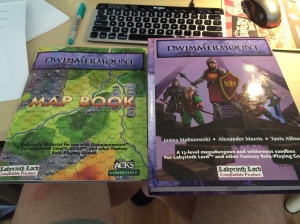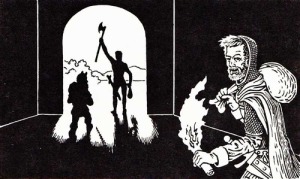Introductory Complaining
If I’m running a low-power game, I like 0-level play: It sets the tone, establishes more of the character at the table, and introduces new players to the game in play rather than in prep. What I don’t like about it is a tendency for the (scant) modules to concretize class restrictions in a particularly unbelievable way. Consider N4: Treasure Hunt:
Zero-level characters all know how to use one weapon. Before your adventure gets underway, have each player choose his character’s weapon proficiency. (Weapon proficiency is explained under “Weapons” in the Players Handbook). A player may only choose dagger, quarterstaff, or dart. Tell the player to write his character’s weapon proficiency on the character sheet.
If, in the course of the adventure, a character picks up a weapon and states that he’s going to try to learn to use it, let him. For simplicity’s sake, let’s assume that, while these characters are in their “state of grace” and learn things speedily, they can learn a weapon proficiency after using the weapon in two combats. A character can learn no more than three extra weapon proficiencies.
Tell the character he should swing the weapon around for a while, get used to its heft and characteristics, and that after a couple of combats in which he uses the weapon, he will have a proficiency with it.
The characters are not limited to dagger, staff and dart after they enter the adventure but, again, the choice of the weapons they learn can limit their character class choices.
If a character tries to learn more weapons during the course of the adventure he starts limiting the number of character classes he can choose. For instance, a 1st level magic- user can only have one weapon proficiency. If the 0 level character learns a second weapon before taking 1st level, he can therefore not be a magic-user when he reaches 1st level. That’s how it works.
Some of this is a consequence of the AD&D weapon proficiency framework, but I’d dread having a conversation at table about whether a PC wanted to surrender the chance to become a magic-user because they used a dagger and a dart. I get bored just thinking about it. Instead, I thought projecting a Jack-of-all-Trades class backwards to 0, with accreting abilities after creation, would work better with the group I’m running a game for.
The ACKS approach to weapons, classes and proficiencies gives a GM some tools to work around the rough spots in the 0-1 progression, and I thought that an ACKS conversion of the Alice class from A Red & Pleasant Land would make an especially good 0-level class for the group I was running.
The Alice: A 0-Level ACKS Conversion
As you might expect, it’s pretty easy to convert between LotFP and ACKS. The Alice is built on the Thief without a backstab ability, and over the course of the 0-1 progression they:
- Get a +1 to hit (going from 11+ on AC 0 to 10+)
- Get a +1 to saving throws (going from Thief 1 with a -2 modifier to a -1 modifier)
- Get a +1 to skill throws in 3 abilities (equivalent to the 1/2 level progression in RPL)
- Get an ability from the Alice random progression table (see RPL, this happens twice)
- Get the exasperation ability (see RPL)
There’s a lot of room there to set up minor XP milestones or success feedback checks along the course of an adventure to result in level 1 Alice characters, and none of it is jarringly binary (with the possible exception of exasperation, but that worked well to establish the kind of fantastic space the PCs were in).
The ACKS Thief skills improve more-or-less by 1 with each level, so I started them with thinly renamed throws as follows:
- Take Things Apart: 19+
- Find Hidden Things: 18+
- Sleight of Hand: 18+
- Be Not Heard: 18+
- Climb: 14+
- Be Not Seen: 19+
- Eavesdrop: 14+
Three of those are 1 better than would be expected from the ACKS Thief, but I thought it was fair for the worse initial climbing and rounding the 1/2 level progression down to improving 3 skills instead of 4. Given the style of progression, I found it easier to leave the throw targets static and have the players record a modifier on their character sheets.
Play Report: Waking Up, or Possibly Falling Asleep, in a Library
Caddy Jelleby, Percy the Urchin, Robert Call-Me-Bob, Scotia and Tadcaster awaken with a start from the falling dream in a library (map) with a ruined roof. A quick wealth roll revealed the quality of their clothing and the number of things in their pockets (modifier of a 3d6 roll, +1).The room they were in was full of numerous books, crockery, broadsheets from all over the world, several partial decks of playing cards, and a military saber (with which Scotia armed herself). Feeling like they needed to find a place with a sturdier roof to escape the snow beginning to fall, the 5 of them set out to look for an exit.
When two of them tumbled into the giant pneumatic tubes under the map room’s floor, the rest followed and were shunted to a reference desk staffed by the last remaining librarian: A hulking bear in a tweed suit named Ian. Ian drinks gin from a porcelain tea set (-3 to hit and AC when drunk, save vs poison each round or lose an attack to hiccoughs). Ian dissembles over questions he doesn’t know the answer to, and is prone to fib responding to those he does. Ian regards the PCs as items from Special Collections, and makes up elaborate classifications for them that shape the contents of rooms in the library.
Ian can be tricked into classifying PCs as outdoor goods, he can be killed leaving his pneumatic controls to the PCs to decipher, or he can be bargained into “remaindering” the PCs outside by bringing him the 2 dozen or so catalog cards that have gone missing. His catalog is full of many shifting cards- if the drawers are turned out, the cards will flap through the air on a middle crease like a swarm of bats.
The 5 PCs set out to find the cards. They discover a talking penguin named Birdtha who just wants to go home to Pengland, and promise to aid her (Caddy: “a quest!”). They discover the missing cards being used as a makeshift deck in a Euchre-LARP conducted in an inexplicable garden party in one of the library’s salons. After establishing one of their own as the best, correct, and right bower, the PCs won most of the tricks (but not all). They cheated by swiping the last trick, and an enraged Left Bower (a level1 Alice) came after them with a sword-cane. Scotia confronted him in the doorway with the saber, and Poor Percy seized the opportunity to drive a silver letter opener into the poor Bower’s neck. The rest of the party fell into panicked chaos as the Left Bower fell dying to the ground, and the PCs escaped with the cards.
Ian proved trustworthy enough in the card exchange, and the PCs ended the session shunted into a bin outside the library with the saber, some maps and newspapers, and about 40 xp apiece. The xp is earning them 2 of the accumulating abilities before the next session.










What People Say to the Mule